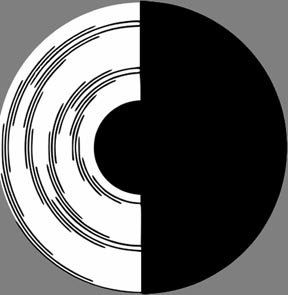
Benham's top, also referred to as Benham's disk.
When spun, colors such as maroon, gray-green, hints of pink and dark blue can be observed.

FECHNER COLORS
In 1826 the French Monk Pre'vost recorded that if he moved a piece of paper across a bright sunbeam in a darkened room, he perceived hints of the colors purple and yellow. Twelve years later, the German philosopher, physicist and psychologist Gustav Fechner published a paper on what he called "subjective colors," which were visible when a black and white disk was rotated. While others would advance his work, this paper was so seminal that almost 200 years later his name remains associated with the phenomenon. In 1895, Charles Benham popularized this effect by selling spinning tops with a black-and-white pattern on them that produced colors when spun. The toy became extremely successful and in so doing introduced millions of people to Fechner's phenomenon.

Benham's top,
also referred to as Benham's disk.
When spun,
colors such as maroon, gray-green, hints of pink and dark blue can be observed.
The order in which the colors appear depends on the direction the disk spins. The brightness and depth of color is affected by the brightness and quality of the light illuminating the disk. Fluorescent lights intensifies blues, incandescent lights strengthen reds. Bright light make brighter colors but if too bright, such as direct sunlight, can wash them out. The black-and-white patterns also affect color production. Some produce bright colors in a broad range. Others produce none at all.
Some people are more receptive to seeing Fechner colors, others less so. However, this may be affected by the pattern on the disk and viewing conditions. Someone who usually doesn't see patterns on one disk may do so if a different disk is used.
The colors are always very subdued and take some experience to spot.
(Sight is the most complex and least understood of all the senses. The explanation offered below is consistent with accepted theories but employs simplifications which, while not crossing the lines of accuracy, bends them slightly in the interests of brevity and clarity.)
The human eye sees when light sensitive cells in the eye's retina are excited by light. These cells are divided into rods, which respond to brightness, and cones, which respond to colors. Cones are further divided into three groups: one for red, one for green and one for blue. When one of these cones is excited by light for which it is designed to respond, it sends an electro-chemical signal to the brain. The vision center in the brain combines this information with that of all the other cones and from this data decides what color to paint on that part of the image we're seeing. The two important points are that (1) the process of seeing color is based on a chemical reaction in the cone and (2) that the actual color we see is created in the mind not just by the input of one set of cones but from the blend of signals from all of them.
Because seeing is based on a chemical reaction, it can't be instantaneous. It takes a very short, but still finite, amount of time for one of the three sets of cones to respond to seeing their particular color, and equally, to respond when that color stimulation is removed. Every chemical reaction progresses based on the nature of the chemicals involved. Touch a match to a piece of nylon rope and it will start to burn very slowly. Touch a match to a pile of gunpowder and that reaction will progress significantly faster. The same is true for the eye's cones. Because each of the three sets of cones has a slightly different chemical reaction that corresponds to its color, then each set of cones responds to the sudden appearance, or absence, of its color with a slightly different speed. If they are all being stimulated by white light and the light suddenly goes out, it turns out that because the red chemical reactions stops faster than blue and greens, then as the white light fades there will be slightly more blue electro-chemical signal being sent to the brain than red. The result is that the brain will interpret this as the white light looking slightly blue or green as it fades. The same happens in reverse. When a bright white light suddenly appears, red reacts faster than the blue and greens so the brain's initial interpretation will be that the white light looks slightly reddish. The color illusion perceived depends on purity of the initial white light, whether it's turning on or off and how fast it does so.
Normally, these processes happen so rapidly that they are impossible to notice. However, in the case of Fechner's spinning disks or Benham's tops the brief hint of color repeats every time the disk rotates. When the rotational speed is optimal, these minute flashes in the brain build up enough persistence to be noticed. It's important to note that these colors aren't really being seen. The eyes are looking at a disk with zones that flash white and black. But the time limitations of the chemical reactions that send signals to the brain fool the brain into thinking it's seeing colors. This is why no one can photograph Fechner colors. There aren't any colors to photograph. It would be more accurate to refer to them as Fechner's color illusion.
What none of the references I found could explain was why different colors appear at different radii from the center of the disk and why the order of the colors reverses when the direction of rotation reverses.
Age, health and individual uniqueness affect the reaction speeds of the cones, which is why some people can't see Fechner colors. Since many of these factors change over time and circumstances, someone who can't see the colors on one day may be able to do so on a different day. The pattern on the disk as well as the rotation speed also play a major roles. Finally, the colors are so subdued that a person may be seeing them but not recognizing them. It's a little like the 3-D hidden image pictures. They're easy once you get the hang of them, but frustratingly difficult until then. The most common colors are a dark red or maroon, a pale gray-green and dark blue. Under the proper conditions orange and a dirty yellow will appear. Occasionally the dark blue deepens to purple.
Most Fechner disks are divided into two distinct semicircles. One consists of (usually) concentric black arcs against a white background. The other semicircle is typically solid black. The purpose of the solid black semicircle is to increase contrast so the faint colors are easier to see. This is the same effect that makes black opals appear to have brighter colors than crystal opals. The color producing areas may be equally bright in both gems but the black background of the black opal make the colors stand out more.
To discover which black-and-white disk patterns worked the best, I searched for as many different patterns as possible, printed them on card stock, cut them out and attached them one at a time to the face of a disk sanding attachment in an electric drill. Testing each in turn, I was able to determine which produced the strongest color illusions and which did not. Along the way I also learned that for the most part the rotational speed needs to be between 80 and 300 revolutions per minute (rpm.) Faster and the spinning pattern blurs into shades of gray. Slower and the color illusion doesn't appear. The following list presents what I found, starting with the least interesting:
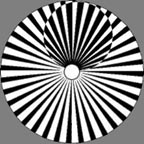
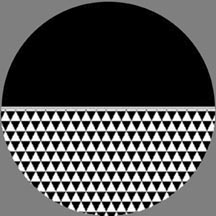
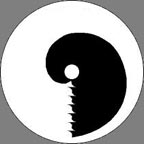
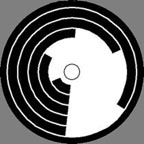
I could not get the Fechner color illusion from any of the four disks above no matter what light was used, how fast the disk rotated, or in which direction. This is particularly odd in the case of the disk that's second from the right because that is the design many references cite as being what Fechner used.
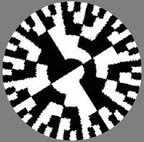
Displays very weak hints of blue one-third from the center when rotating 120 rpm counter clockwise. When rotating 120 rpm clockwise the weak blue zone moves to two-thirds out from the center. This is a poorly performing disk.

Hints of dirty yellow over gray halfway out form the center in both rotational directions. Not very interesting.
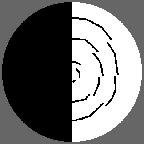
Clockwise rotation at 150 rpm produces a brown-yellow streak halfway out from the center with a pale blue streak close to it but slightly further out. A second similar pair shows up two-thirds of the way out. With counter-clockwise rotation the brown-yellow and pale blue streaks are reversed but their distances from the center are the same. The color illusion is weak and not very satisfying.
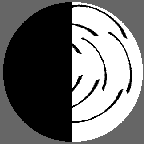
Counter-clockwise rotation at 180 rpm produces a faint green one-third from the center, a dirty yellow halfway out and a brownish-red streak near the edge. Reversing the rotation yields hints of green near the center and a moderately solid red-brown streak halfway out. At higher speeds the red-brown streak holds up well, turning into an almost solid arc.
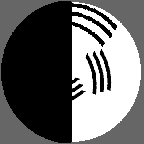
The outer three arcs produced hints of light pink when rotating counter-clockwise at 150 rpm. Clockwise, at the same speed, I saw a hint of pink in the center and two very faint gray-green lines slightly further out.
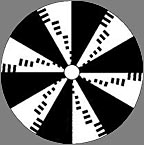
This pattern is interesting because it works best at very low speeds, typically 80 rpm. Clockwise, one-third the way out from the center shows three faint pink lines followed by three pale gray-green lines and finally three bluish lines. Reversing the direction of rotation reverses the order of colors.

This is one of the more interesting Fechner disks. At 100 rpm, counter-clockwise, the central four arcs appear strongly purple while the next three look pale blue. Beyond that the disk has a slightly yellow tint. Increasing the speed to 180 rpm changes the center arcs to blue, the middle arcs light green and the outer three arcs a dark red-brown. Driven clockwise, the colors are reversed, but the purple is almost impossible to perceive in the outermost ring. The red of the center four arcs is stronger but the rpms have to be kept slower for the colors to be as strong. Considering that this disk is almost identical to the one two spots earlier, it's surprising how much better it works. Making sure the arcs are concentric appears to be important.

At 120 rpm clockwise there is a solid maroon circle near the center, a very pale but solid gray-green circle next and finally an extremely dark blue, almost black, arc near the edge. More interestingly, this is one of the few Fechner discs that holds colors at rpms up to 600. At that speed the colors have a lot of gray in them but from center outward are clearly violet, brown-red, pale green and very dark blue. Reversing the direction of rotation reverses the colors. However, now the outer ring, which should be violet, is blue.
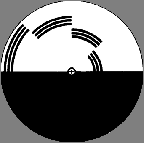
This disk is identical to the previous one except that the solid arcs have been divided into three fat lines. At 100 rpm clockwise, the center three arcs appear maroon and all the other arcs look dark blue. At 150 rpm the center turns more reddish, the next set of lines yellow-green, then gray green, then blue. At 600 rpm the center looks gray-violet, then dull, faint gray-red, gray-green and finally dark blue. The colors reverse order when the direction of rotation is changed. This is an excellent disk for showing the effect of speed on color density. At low rpms the colors appear solid and more saturated, but they flicker. At higher rpms the colors look washed out but appear to be continuous circles all the way around the disk.
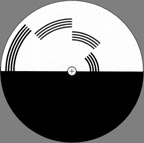
Next we have the solid-arc disk again but this time the arcs are divided into four thin lines. At 120 rpm clockwise the center arcs now look decidedly red, not maroon. At higher speeds the violet in the central violet zone is stronger and the next set of arcs outward has a hint of pink in it. This pinkish zone sometimes hints at orange. Otherwise it performs the same as the previous disk. Of all the Fechner disks tested I'd rate this one as the best.
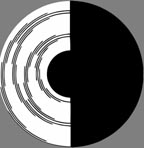
This last disc is the one used in Benham tops and is by far the most complex and also the most frustrating. It produces some of the brightest, clearest reds but the spiral-like pattern of the arcs makes them appear to be moving inward and outward so there is never one place you can focus on to study them. It's like looking at meteors. Just when you spot one, it's moved on to somewhere else. Clockwise rotation at 150 rpm produces two streaks of red moving apart inside each wedge shape defined by the fine lines. Underneath these red lines is a hint of green while outside is a line of very dark blue.
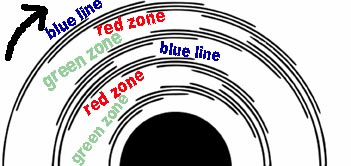
This Benham disk appears to produce much clearer colors when rotating clockwise than counter-clockwise.
For my money I think the following is the best. It's been enlarged in case anyone wishes to copy it to create their own Fechner disk.
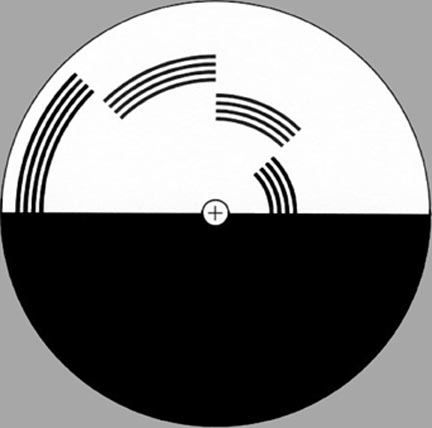
Making sure that the disk rotates exactly about its center is important for achieving maximum color saturation. If the disk rotates off center the colors will be more muted. Slower rpms create comet-like streaks of colors that look deeper and richer but flicker. Higher rpms produce more even bands of colors that are less saturated.
Why Don't Videos Capture Fechner Colors?
As with still photos, there are no real colors to record. As to why a video of a spinning Fechner disk doesn't create the illusionary colors, the on-and-off refreshing of computer monitors interferes with the flickering of Fechner disks and in so doing blocks the Fechner illusion from being created in the viewer's mind. In the following video I can't detect any color, yet as I shot the video I could clearly see a wide range of strong colors when I looked directly at the disk:
I've previewed a dozen other Youtube videos and while a few of them displayed some beige lines, none of them created anything like the full color illusion.
The following video shows a simulation of what the Fechner disk above looks like when viewed in person:
In actual use the colors are slightly more intense, particulary the blue, which is a deep, rich midnight blue.
Conclusions:
Fechner colors are real, but illusionary. They don't exist in the external world but do exist within our brains. While they may be subdued compared to real colors, the fact that they can spring from pure black and white is nothing short of miraculous. I used family members as test subjects and they could all see the colors. I suspect the claim that some people can't see them is more the product of their not being trained to spot the colors than some physical or mental deficiency.
The best patterns for producing colors appear to be those with just a few sets of concentric arcs. Very complicated designs tend to wash out to gray even at low rpms. Non-concentric arcs produce weaker colors but sometimes create the rare pink.
I experimented with a Fechner cylinder, a tube marked with a pattern similar to the most effective disk pattern, but no matter what rotational speed I used I could not create Fechner colors with it.
Fechner disks are inexpensive and easy to make and are great science projects for school or personal interest. There is surprisingly little detailed information available on which disk designs produce the best colors so the field is ripe for exploration and discovery.
I sincerely hope you found this page helpful and wish you the best of luck in your study of this interesting phenomenon.
Return to my main page to browse 60 other subjects